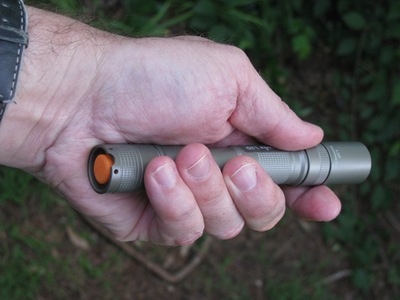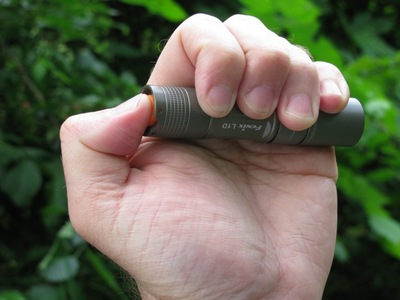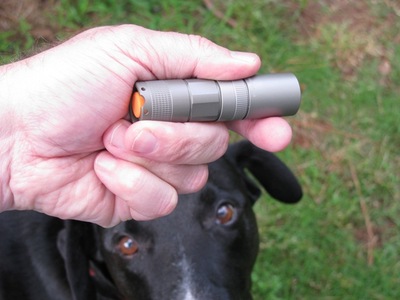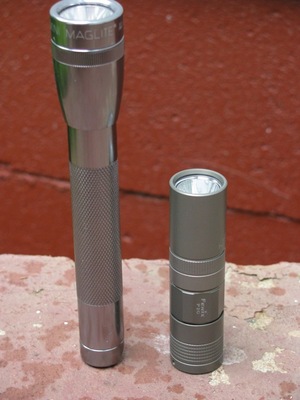Fenix L2D Flashlight
After upgrading my three mini Maglites and my Snakelight, I realized that what I really needed was a flashlight that could be really bright, but that you could also make not as bright if that was what was needed or if you just wanted the battery to last longer. Maglite actually has a multi-mode LED mini that you can find and which I wrote about more in my Maglite post.
One thing about the LED lights is that they work at pretty much constant brightness until the battery dies. NiMH batteries die off pretty quickly so you go from having plenty of light to having no light with almost no warning. Some of the multimode lights though will sense when the battery is getting low and drop a level of brightness, giving you some notice. One thing to watch out for is that some lights create a low mode by flashing a bright light very quickly, something called pulse width modulation or PWM. If you move the light quickly you get a kind of strobe effect. It's better to have an actual lower light level.
On Candlepower Forums everybody has expensive flashlights. One expensive brand is called Surefire. But there is a more economical brand that produces well-made lights that are very efficient called Fenix. I would want something that uses regular batteries like AA's (C and D's being too heavy and AAA's not providing enough oomph for a bright light to last very long). Many of the high end lights use CR123A batteries like my old camera used (expensive, though you can find them online cheaper: $1.50 apiece) or 18650 cells which look like AA's but are actually Lithium Ion rechargeables that run at 3.6 volts (would need a new charger and CPF people are saying that rechargeable Li-Ion batteries can explode). 2 AA batteries seems like a good spot although those others are more compact.
I also wanted something as bright as possible with less bright modes available. A few years ago Fenix introduced a model called the L2D that met all of those requirements (they sold the same flashlight in a more compact form that uses one AA battery and isn't as bright called a L1D, see above; they also make a P2D that is just as bright as the L2D except it uses one CR123A battery so it is much shorter, see below). I could buy a P2D body (Lighthound has a big selection of parts so I did end up buying a P2D body and tail along with a L1D body; they included a free small keychain LED light that is brighter than my AAA Minimag TLE-20 upgrade for spending more than $20, plus shipping was only $3 so thumbs up for them) and attach it to my L2D head making for a much smaller light that would be easy to carry around in a pocket (this is why the Candlepower people like the CR123A-powered lights and they use them as their "everyday carry" or EDC light), however on turbo mode the CR123A burns up in 30 minutes vs. 90 minutes for 2 AA batteries. The L2D has a turbo mode of 180 lumens with other modes at 107, 55, and 12 lumens (Fenix tends to exaggerate their lumens compared with some others like Surefire; reviewers have said the $150 120-lumen Surefire E2DL is brighter than than the $50 180-lumen L2D). I like that range of light levels. Some others have only 2 levels which are both pretty bright (Eagletac P100A2 has 195 and 55 lumen brightnesses) or one bright and one that seems not bright enough. The turbo isn't a whole lot brighter than the second highest level, but it is noticeable: it's like turning the flashlight up to 11. The L2D also has a rapid flash mode on the brightest setting that they claim can disorient an attacker.
There were different LED's available in the L2D, so I had to make sure I was getting the Q5 version with a Cree XR-E LED. Others like the Luxeon Rebel or P4 weren't quite as bright, but the Cree is brighter with the same runtime.
So the L2D had good reviews, was bright, good quality, etc. It comes in two colors: black and olive. Black seems like the standard but someone at CPF pointed out that if you are looking for a flashlight, chances are it is dark so why would you want black? Most of the Candlepower people seem to go with olive, so that's what I picked. Then the next question was whether to get the L2D or the newer version of the same light called the LD20 (and LD10 and PD20). It seems like I read some reviews saying people didn't like the LD20 as much, but in retrospect I think I should have paid $3 more and gotten the LD20. Even though it is still an expensive light (about $50) I figured I would use some of the money from my iPod ads, so that it's not like I'm really paying for it. Otherwise I can't justify spending all the money on the flashlight and the Mag upgrades.
The last variable (I think) is the reflector that goes around the bulb. There is a smooth one and a textured one. The textured one just scatters the light a little more and sacrifices how far the beam will shine ("throw"). Mine came with a smooth reflector (the eBay ad didn't say which reflector it had). Some textured reflectors are in a pattern called "orange peel" while others just have a coating that diffuses light. Some people put Scotch tape over the lens to get a similar effect.
There is another variable, though not really, which has to do with the on/off switch (called a "clicky"). With Surefire and other brands you can halfway press the button (favorite location is on the tail end of the light) and it will light. If you fully press the button it will click and stay on. But Fenix has a "reverse clicky" which you can only click to On and then if you halfway press the button (really just touch it; it is very sensitive) it will turn off until you let go. So with Fenix it isn't an option, they are all reverse clicky. The L2D changes brightnesses by doing a quick half press once it is on. If you hold the half press the light stays off and when you let go it is on again in the same mode.
Anyway, I got the light today in the mail. It is smaller than I thought it would be but is basically the same size as a Mini Maglite. The smooth reflector still produces a good circle of light with a center that is significantly brighter than the brightest upgraded Maglite. Fenix says it is 180 lumens, which is probably a good number compared to the 140 lumens claimed by the Maglite upgrade. The light is whiter and whereas the Maglite has a defined center circle of light, this one is not. The quality seems good, similar to a Maglite with a metal body and screw-in head and tail with rubber o-rings to make it watertight (to IPX-8 which means 8 ft. of water for 30 minutes). But it has the better light, metal reflector instead of plastic, and glass lens instead of plastic. So it is definitely a big step up. The instructions and packaging were kind of lame and screamed Made in China.
Here's an extensive review with pictures of the olive version like mine:





Comments (2)
I like the idea of getting an AA driven light because we always have 4 AA's charging to support our cameras, wireless keyboard, and wireless mouse. However, I rarely need a flashlight. It seems like everything is lit up including every nook of my car. How often do you use a flashlight?
Posted by jeb | May 23, 2009 6:48 PM
I don't really need a flashlight very often. However it is kind of nice to have one when walking the dogs at night or if they get into something in the backyard and I feel like I need to go check it out. I certainly have plenty of flashlights now.
Posted by UT | May 23, 2009 10:28 PM